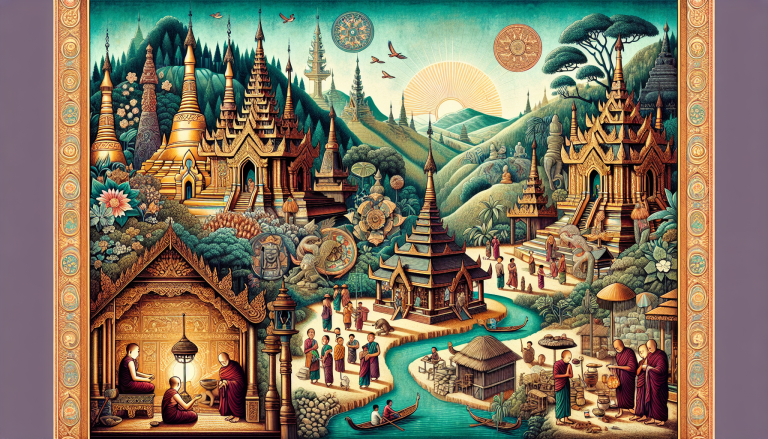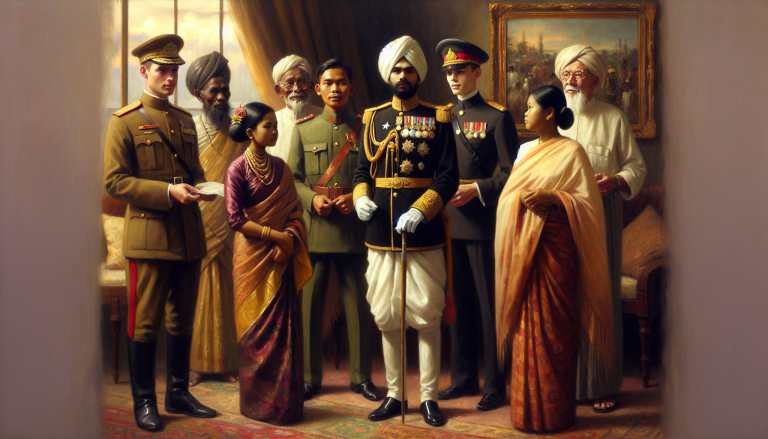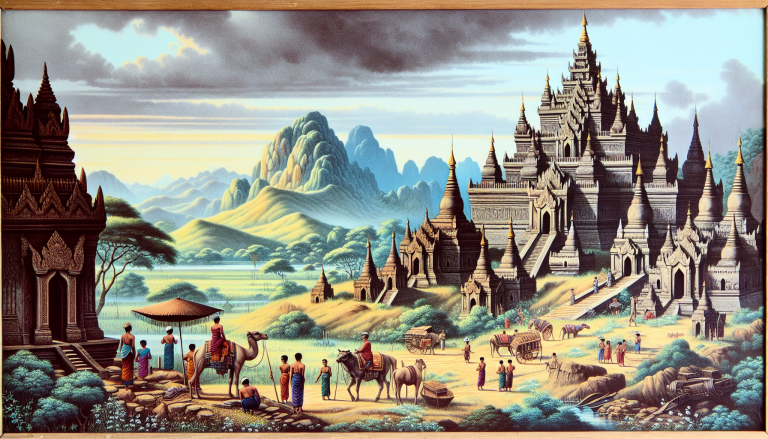Unveiling Myanmars Marvels: Your Guide to Civilization Achievements
Discover Myanmar civilization achievements! Explore ancient wonders and modern marvels in this friendly guide.

Ancient Civilizations in Myanmar
Delve into the rich tapestry of Myanmar’s past, beginning with its ancient civilizations that laid the foundation for its notable cultural achievements.
Early Human Settlements
Myanmar, situated in the heart of Southeast Asia, has been inhabited by humans for thousands of years. The first human settlers in the region appeared around 11,000 years ago in the central plain, representing a Paleolithic culture (Britannica). These early inhabitants were pioneer gatherers and hunters, using primitive stone tools for their daily survival.
About 10,000 years ago, early Neolithic settlements began to emerge, particularly in the Shan state. These communities transitioned from a hunter-gatherer lifestyle to agricultural practices, marking significant progress in Myanmar civilization achievements. The following table highlights key periods and cultural practices of early settlers:
| Time Period (Years Ago) | Cultural Practice | Notable Developments |
|---|---|---|
| 11,000 | Paleolithic | Use of stone tools |
| 10,000 | Early Neolithic | Agriculture begins |
Artifacts such as stone tools and cave paintings found in these regions suggest a gradual but profound shift towards a more settled and organized society. This period prepares you well in understanding the context of prehistoric Myanmar societies.
Hoabinhian Culture
As you explore the depths of ancient Myanmar civilization, you will come across the fascinating Hoabinhian culture. Spanning from approximately 13,000 to 5000 or 4000 BCE, this culture was a key prehistoric society in Southeast Asia (Britannica). The Hoabinhian people are known for their unique tools and rice agriculture developments.
The Hoabinhian culture is characterized by:
- Stone tools with distinctive shapes, known as sumatraliths.
- Early evidence of change from hunter-gatherer societies to settled agricultural communities.
- Technological advancements such as pottery and rudimentary metallurgy.
The following table presents a summary of the Hoabinhian culture’s key contributions to early civilization in Myanmar:
| Aspect | Description |
|---|---|
| Time Period | 13,000 – 5000 BCE |
| Key Developments | Stone tools, pottery, early agriculture |
| Regional Influence | Spanning across Southeast Asia |
Hoabinhian culture provides insight into how early human innovations in Myanmar contributed to the broader Southeast Asian civilizations. By understanding this culture, you gain a richer perspective on how early societies like the Hoabinhian took significant steps towards more complex societal structures—something you can further explore in southeast asian civilizations.
These early periods and contributions lay the groundwork for subsequent civilizations, such as the Pyu city-states and the Pagan Kingdom, which you will learn more about in ancient Burmese dynasties and bagan kingdom history. As you navigate through Myanmar’s historical timeline, you’ll uncover how these early achievements influenced later societal developments, which you can explore further in myanmar civilization achievements.
Evolution of Myanmar Civilization
Pagan Kingdom
The Pagan Kingdom (1044–1297) represents a fundamental period in the development of Myanmar. It was the first-ever unification of the Irrawaddy valley and its periphery, marking the establishment of the Burmese language and culture (Wikipedia). King Anawrahta, who founded this state at Pagan in 1057, made significant contributions by adopting Theravada Buddhism. This was a key milestone in Myanmar civilization achievements, shaping the religious and cultural landscape of the region (BBC News).
Under Anawrahta’s rule, the Pagan Kingdom unified the modern-day regions of Myanmar and extended its influence into the upper Malay Peninsula, Salween River, and northern Arakan. By the early 12th century, Pagan had become a major power recognized by both Song China and the Chola dynasty of India.
| Period | Key Developments |
|---|---|
| 1057 | King Anawrahta founded the first unified Myanmar state at Pagan |
| 1044–1297 | Established Burmese language and culture; adopted Theravada Buddhism |
| Early 12th century | Recognized by Song China and Chola dynasty |
For more detailed information, visit our section on Pagan Empire Myanmar and Bagan Kingdom History.
Konbaung Dynasty
The Konbaung Dynasty (1752–1885) was another pivotal era in Myanmar’s history. This dynasty emerged after the dissolution of the Toungoo dynasty and played a crucial role in shaping the country’s modern boundaries and political structures. The Konbaung rulers carried out significant administrative, military, and economic reforms, thereby stabilizing and expanding the kingdom.
One of the most prominent figures of this period was King Alaungpaya, who founded the dynasty. He reunified the country and established a centralized authority. This dynasty also witnessed extensive territorial expansions, including invasions into neighboring regions, such as Siam (modern-day Thailand).
| Period | Key Rulers | Key Achievements |
|---|---|---|
| 1752 | Led by King Alaungpaya | Reunified country, established centralized authority |
| 18th–19th centuries | Various rulers | Territorial expansions, military, administrative reforms |
The Konbaung Dynasty’s influence is substantial when studying Burmese Monarchs and Myanmar Kingdom Boundaries.
For travelers interested in further diving into these periods, don’t miss our resources on Theravada Buddhism in Myanmar, Myanmar Royal Lineage, and Myanmar Political Structures. Exploring these links will provide deeper insights into the rich history and culture of Myanmar’s ancient and evolving civilizations.
Key Milestones in Myanmar History
Exploring the rich history of Myanmar reveals essential milestones that have significantly shaped its civilization. Here, you’ll journey through pivotal eras, starting from the Pyu city-states to the influential Toungoo Dynasty.
Pyu City-States
The Pyu city-states mark the beginning of recorded history in Myanmar. These states emerged in the Irrawaddy valley around the 2nd century BCE. By the 4th century, they had established themselves as prominent centers of commerce and culture. The Pyu introduced Buddhism to the region, converting many inhabitants and laying a foundation that would influence Myanmar for centuries.
The Pyu civilization thrived for nearly a millennium until the early 9th century. Their decline began when the Kingdom of Pagan started to rise, gradually absorbing the Pyu city-states over the next four centuries. Despite their assimilation, the Pyu left an enduring cultural legacy, particularly in terms of their religious and linguistic contributions.
| Formation Period | Significant Contributions | Decline Period |
|---|---|---|
| 2nd Century BCE | Introduction of Buddhism, Early City-State Formation | 9th Century CE |
For further insights into this period, you can explore detailed articles on the Pyu civilization in Myanmar and ancient Myanmar scripts. Hidden among ancient Myanmar ruins, you can still witness the remnants of Pyu architecture and culture.
Toungoo Dynasty
The Toungoo Dynasty emerged in the early 16th century, ushering in a new era of political unification and expansion. Founded in 1510, the Toungoo Dynasty succeeded in reunifying Myanmar and creating the largest empire in Southeast Asia during the latter half of the 16th century (Wikipedia).
The dynasty is particularly noted for its administrative and economic reforms, which lead to a more stable and prosperous kingdom. Under the leadership of kings like Bayinnaung, the empire extended its reach from the regions around Pagan to the borders of modern Thailand, achieving significant military and diplomatic victories. These reforms and expansions established the dynasty’s influence, which lasted until its decline in the 18th century (Wikipedia).
| Reign Period | Major Achievements | Decline Period |
|---|---|---|
| 1510 – 1752 | Largest SE Asian Empire, Administrative and Economic Reforms | Mid-18th Century |
For more about this period and the rulers who shaped it, visit articles on ancient Burmese dynasties and Burmese monarchs. Additionally, delve into how regional boundaries evolved over time through Myanmar kingdom boundaries.
These milestones provide just a glimpse into the vast and intricate history of Myanmar. For a comprehensive grasp of other significant historical events and periods, check out our complete burmese history timeline and historical sites in Myanmar to further enrich your understanding of this fascinating land.
Modern Myanmar Civilization
British Colonial Rule
During the period of British colonial rule, Myanmar, then known as Burma, experienced profound changes. The British separated religion and the state, which drastically transformed traditional society and led to enduring social, economic, cultural, and administrative changes (Wikipedia).
Key Events During British Rule
- First Anglo-Burmese War (1824-26): Resulting in Burma ceding the Arakan coastal strip to British India in the Treaty of Yandabo.
- Annexation of Lower Burma (1852): Following the Second Anglo-Burmese War.
- Final Annexation (1885): After the Third Anglo-Burmese War, Burma was fully annexed into British India.
| Event | Year | Outcome |
|---|---|---|
| First Anglo-Burmese War | 1824-26 | Ceded Arakan coastal strip |
| Annexation of Lower Burma | 1852 | Incorporated into British India |
| Third Anglo-Burmese War | 1885 | Full annexation |
Explore more on the burmese history timeline.
Contemporary Political Landscape
Since gaining independence from British rule in 1948, Myanmar has encountered numerous political upheavals. The post-independence era has been characterized by military dominance and a continuous struggle for a stable democratic system.
Key Milestones in Modern Politics
- Military Rule (1962-2011): General Ne Win led a coup in 1962, establishing a military junta that ruled the country for almost five decades (BBC News).
- 1990 General Election: The National League for Democracy (NLD) won a landslide victory; however, the military ignored the results (BBC News).
- Transition to Semi-Democracy (2011): The military began to relinquish direct control, leading to significant political changes.
| Period | Description |
|---|---|
| 1962-2011 | Military-led government |
| 1990 | NLD wins election; results ignored by military |
| Post-2011 | Transition to semi-democracy |
To understand more about Myanmar’s journey towards a democratic system, visit myanmar political structures.
For avid travelers and history buffs, uncovering the achievements of Myanmar’s civilization offers a rich and textured understanding of this diverse and dynamic nation. From British colonial influence to contemporary political developments, Myanmar’s history is a fascinating topic. Learn about more burmese historical events and theravada buddhism in myanmar for a comprehensive exploration.






